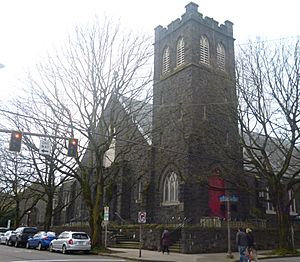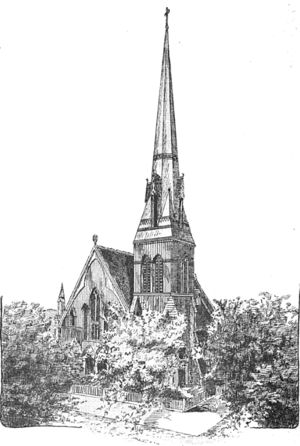Trinity Episcopal Cathedral (Portland, Oregon) facts for kids
Quick facts for kids Trinity Cathedral |
|
|---|---|

Northern entrance featuring the bell tower at the intersection of 19th and Everett streets
|
|
| 45°31′28.41″N 122°41′27.66″W / 45.5245583°N 122.6910167°W | |
| Location | 147 NW 19th Ave. Portland, Oregon |
| Country | United States |
| Denomination | Episcopal Church in the United States of America |
| History | |
| Founded | May 18, 1851 |
| Consecrated | October 14, 1906 November 19, 1993 (as a cathedral) |
| Architecture | |
| Architectural type | Gothic Revival |
| Completed | 1904 |
| Specifications | |
| Materials | Basalt, Sequoia |
| Administration | |
| Diocese | Oregon |
Trinity Episcopal Cathedral in Portland, Oregon, is a church that belongs to the Episcopal faith. It's the main church, or "seat," for the Episcopal Diocese of Oregon. You can find it at 147 NW 19th Avenue in Portland's Northwest District.
The church was first started on March 18, 1873, as Trinity Episcopal Church. It became a cathedral on February 17, 1994. This happened after the Episcopal Bishop of Oregon moved the main church office to this location. Bishop Robert Louis Ladehoff officially made it a cathedral on November 19, 1993.
Trinity Cathedral is the central church for the Episcopal area that covers parts of Oregon west of the Cascade Mountains. About 1800 people regularly attend services and join in church activities. The church also runs a Center for Spiritual Development, which helps people learn and grow in their faith.
The head of the cathedral is called the Dean. The current Dean is the Very Rev. Nathan LeRud. He works with other clergy members, including the Rev. Matthew Lawrence. Marcus Borg, a well-known New Testament scholar, also served the church as a Canon Theologian. Portland Mayor Ted Wheeler sometimes attends services here.
A Look at Trinity Cathedral's History
Trinity Episcopal Church began on May 18, 1851. The Rev. St. Michael Fackler and the Rev. William Richmond, along with four church members, started it in Portland, Oregon. They held their first services in a new school house. This was the very first Episcopal church group in the Oregon Territory. Fackler and Richmond also helped start other churches nearby that same year.
By 1853, the church had grown to 25 members. They welcomed their first full-time leader, called a rector, the Rev. John D. McCarty. Construction started on their own building at Southwest Second Avenue and Oak Street in Portland. A church member named Benjamin Stark donated the land. This first building was like a log cabin. When it was officially dedicated, it was the first Episcopal church building north of San Francisco and west of St. Paul.
By 1871, Trinity had over 200 members. The church bought a new piece of land for $3,000. In 1872, a new church building was constructed there. This building was meant to show how important the church and the City of Portland had become. A special stained glass window in this church honored Bishop Thomas F. Scott. This window was saved when the 1872 building caught fire. Today, you can see it in the East wall of the current cathedral. Many important people from Portland were members of the church during this time.
In 1873, Trinity Church helped start Good Samaritan Hospital. In 1902, the church building at Sixth and Oak was badly damaged by fire. The church decided to move again to the more popular NW 19th Avenue. Many wealthy church members lived in this area. The new building, where the church still meets today, was dedicated on October 14, 1906. The beautiful stained glass windows were made by the Charles J. Connick Studios in Boston in the late 1940s.
In the late 1970s, the Episcopal Church was changing how it held services. Under the leadership of Trinity's rector, the Reverend William H. Wagner, Jr., the Cathedral was updated. The altar was moved closer to the people, and the front area of the church was changed. This made it easier for everyone to feel more involved in worship.
This redesign was finished in 1983. At the same time, a new organ was built. Trinity hired a young organ designer named Manuel Rosales for the project. In 1987, the Rosales Organ, Opus 11, was completed. It is now known as one of the best organs in the country.
See also





